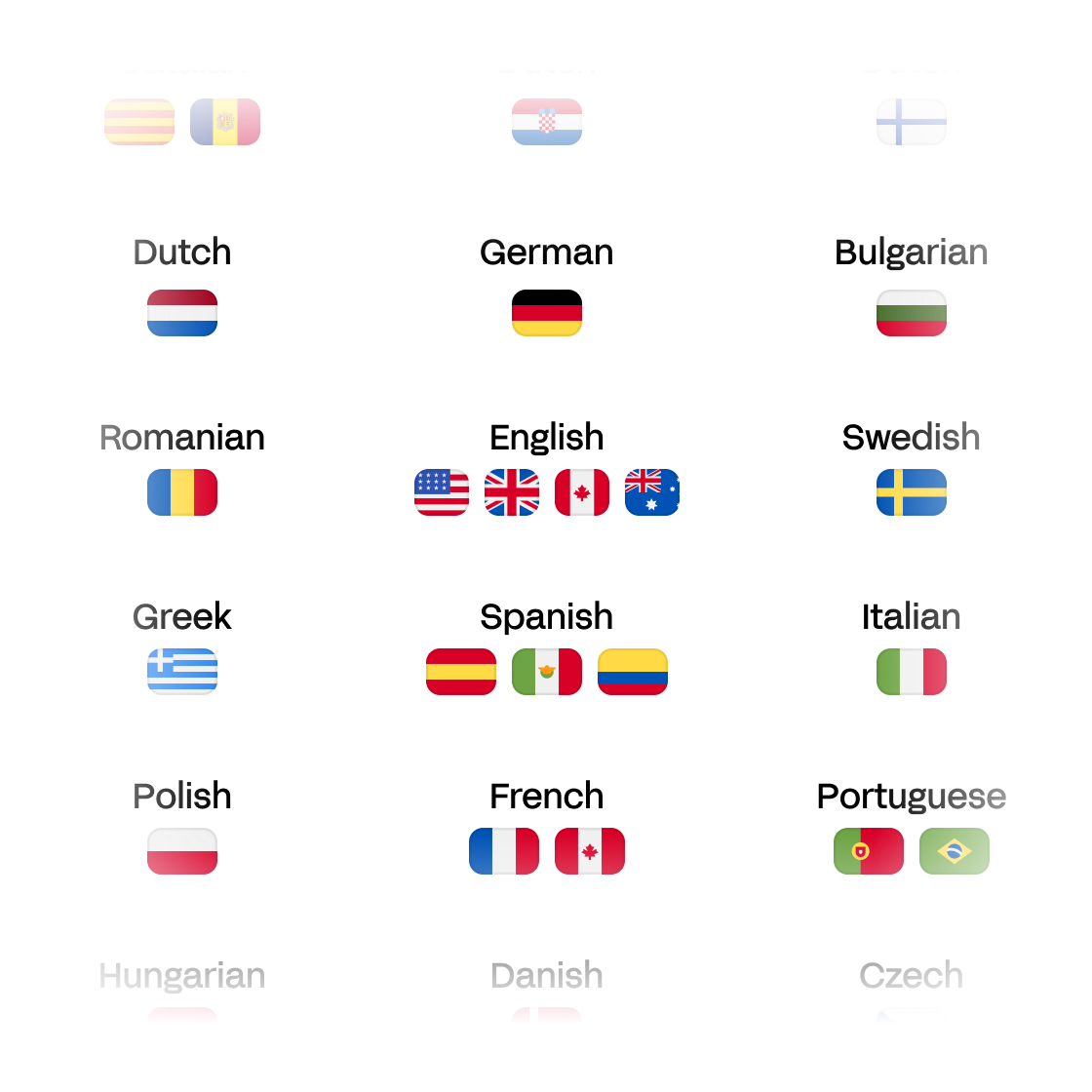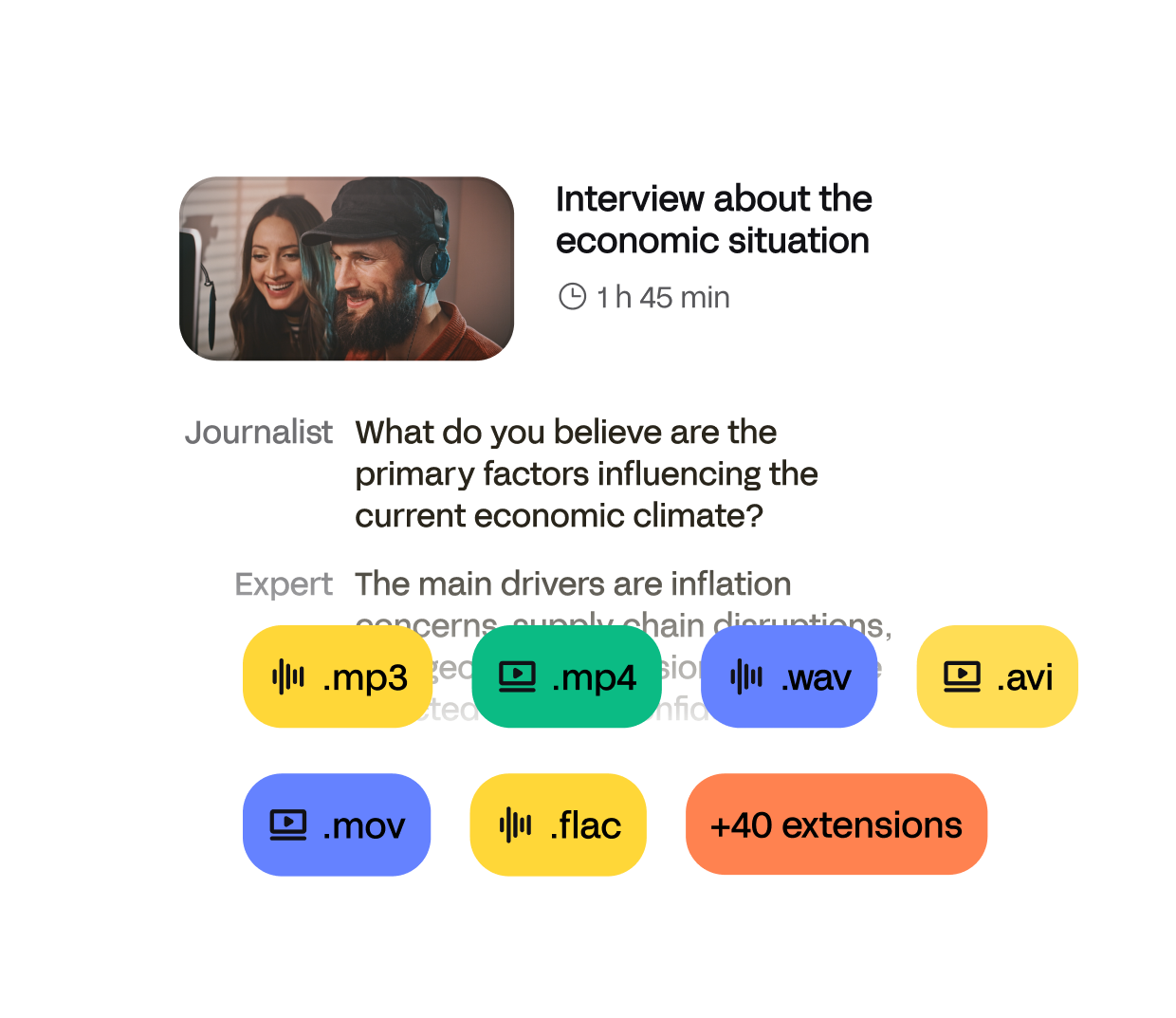
Transcribe 120+ languages
HappyScribe is your partner for transcribing any language from audio to text. We've got the biggest language variety!

Is a multi-purpose tool better or one that focuses on a few key tasks? When you’re looking for an AI transcription tool, it’s common to come across several options that handle varying features and are built with different purposes in mind. Fortunately, you can look at key categories, such as accuracy, language support, collaboration, and security, to help you decide.
If you’re debating between HappyScribe and Clideo, here’s what you should know to choose the right tool for your needs.
|
|
 |
 |
|---|---|---|
|
User experience |
Focused on transcription with advanced features |
Focused on video editing with basic features |
|
Security |
✅ GDPR and SOC 2 Type 2 |
GDPR but not SOC 2 Compliant |
|
Language support |
✅ 120+ languages |
74+ languages |
|
Workflow |
Great for efficiency and collaboration |
More basic and built for individual use |
|
Use cases |
Best for transcription and translation |
Best for video editing |
|
Team collaboration |
Yes |
No |
|
AI assistant |
Yes |
No |
|
Glossaries |
Yes |
No |
|
Subtitle styling |
Yes |
Yes |
|
Subtitle editor |
Yes with advanced functionalities |
Yes with basic options |
|
SDH subtitle compliance |
Yes |
No |
|
Multiple export formats |
Yes |
No |
|
Pricing |
Pay-as-you-go and starting at $9 per month |
$9 per month |
HappyScribe is a language services tool that helps with transcription, translation, and subtitling. It’s built to handle speech-heavy content, such as podcasts, interviews, and speeches. You can use it to turn videos and audio into a text-based format, create summaries, add translated subtitles, and more.
HappyScribe is a professional and focused solution that offers several features that help you collaborate with your team, work efficiently, and ensure accuracy while producing global content at scale.
Clideo is primarily a video editing solution. It offers several tools to help you make basic video edits, such as cuts, merging files, cropping, and adding basic effects.
Clideo can add subtitles, perform audio or video-to-text transcription, and translate audio or video files. However, Clideo’s subtitling, transcription, and translation features act as more of an add-on to its primary video editing solutions than true primary features. It can make it feel more basic than the professional solutions you get with HappyScribe.
We’ll compare both HappyScribe and Clideo in more depth in the rest of this article so you can see the pros and cons of both options.
When you log in to HappyScribe, you’ll notice it feels like a true professional transcription, translation, and subtitling tool. It’s organized and easy to navigate, so you can quickly figure out how to start projects, upload files, and adjust settings to your liking.
Key features that contribute to a professional user experience in HappyScribe are:
The user experience with Clideo will feel a lot different than HappyScribe since it’s focused on video editing.
When you log in, Clideo puts the video editor front and center. It makes it easy to add video files, start new projects, and get editing right away. However, some of the add-on features, like transcription, translation, and subtitling, are buried deeper in the menus, so you have to look through different options to find them.
Once you navigate the menus, performing video transcription or translation in Clideo will feel a lot different than what you get with HappyScribe. Clideo doesn’t actually give you a text-based editor like you’ll have in HappyScribe. Instead, it just automatically adds transcripts as subtitles to the video you uploaded.
To get a true transcript from Clideo, you’ll have to use the option they give you to download it as a TXT file. Then, you can copy and paste that into a different word processor, like a Google Doc or Word Doc, to edit it and format it to your liking.
With that setup, you lose out on a lot of the advanced transcription and translation features you get with HappyScribe, such as the AI assistant, proofreading helper, style guides, glossaries, and automatic speaker labeling. So, while Clideo is great for video editing, the transcripts can feel lackluster for businesses and content teams looking for a more in-depth solution.
HappyScribe has verified accuracy rates for transcriptions of 95% on AI-only outputs and 99% with expert proofreading. The option for added expert human proofreading is a great feature that can help you achieve better accuracy on important content.
AI-only outputs are available within minutes, and expert proofreading is delivered within 24 hours. Professionals on a tight deadline can also add rush orders for expert proofreading to speed up the process.
The team behind HappyScribe cares about providing continuously high-quality results. HappyScribe is tested and trained daily on 12,000+ hours of content each year to ensure it continues to perform at its best and to keep expanding its language capabilities.
You can also use features like HappyScribe’s Glossaries feature to improve the consistency of outputs. The Glossaries feature allows you to correct any words that are frequently misspelled, such as people’s names or company-specific terminology. All you have to do is add the correct spelling to your glossary to have the software correct it going forward.
Clideo doesn’t list an accuracy rate on its website for transcription, so it’s hard to determine how well it’ll perform over a high volume of content.
Clideo also doesn’t mention how often it tests its transcription, translation, and subtitling features to maintain quality and improve them, and they don’t have a glossary feature to correct any frequent misspellings.
Clideo’s transcription and translation features do feel like more of an add-on compared to their video editing tools, so it’s safe to assume they might put less time into developing those. Whereas HappyScribe puts a lot of deep focus into its transcription and translation tools with regular testing because that’s what the platform is built for.
HappyScribe has a wide range of supported languages to satisfy global content production needs. HappyScribe can transcribe in 120+ languages and translate in 65+ languages with AI-only outputs. You can also opt for expert proofreading in 85+ languages when you’re translating or creating translated subtitles.
On top of that, HappyScribe provides several other advanced features that contribute to well-rounded language support:
"Happy Scribe didn’t just save us time—it helped us reach entirely new markets. We’re now engaging audiences in North America, Asia, and beyond. Canada, Mexico, Japan, and China are some of our biggest growth areas."
- Samuel Rostein, Channel Manager at Logicomix
Clideo has 74+ languages and dialects on the platform that it can transcribe and translate in. However, Clideo does note that the software provides better results for some languages than others.
Clideo lists English, French, Spanish, and German as the primary languages it focuses on, and notes that common translations like English to Spanish will have the best accuracy.
It also doesn’t offer the side-by-side editor, localization features, glossaries, or automatic subtitle syncing features that you get with HappyScribe.
Those limitations can make it hard to use Clideo when trying to produce professional content for global audiences, where you need high levels of accuracy to connect with viewers.
HappyScribe’s workflow is built around features that help with collaboration and efficiency during professional use. Features that contribute to that are:
Each of these features is organized in the platform in a way that’s easy to use and accessible to reduce the learning curve when you get started.
"Last year, we were still transcribing in January. With HappyScribe, we had everything sorted by October. The speed difference is huge."
- Georgie Nicholls, Production Manager at Twofour
Clideo’s workflow is much more focused on video editing. The video editor is the main part of the platform you’ll be working in while using most of the tools Clideo offers. That can detract from the workflow when working on tasks like transcription or translation that aren’t Clideo’s main focus. Those features feel more like add-ons that aren’t completely built out.
Aside from that, one of the major drawbacks of Clideo is that it doesn’t have an option to collaborate with your team on the platform. It’s more of a platform for simple projects and individual use. That’ll lead to issues for businesses that want to add it into professional workflows.
Additionally, it lacks other helpful features that HappyScribe offers, such as creating custom folders for project files, speaker tagging, and creating audio summaries. Plus, while it offers some subtitle styling options, it doesn’t have quite as much customization as HappyScribe does for elements like subtitle weight and appearance.
HappyScribe takes user security and privacy seriously. As a European-based company, HappyScribe is fully GDPR compliant to ensure high security standards while processing and handling information.
Additionally, HappyScribe provides further layers of security by being SOC 2 Type 2 compliant and offering secure single sign-on (SSO) login.
Clideo is a company based in Germany that is also fully GDPR compliant. However, Clideo isn’t SOC 2 compliant, so that is an important consideration when looking for tools for business use that you want to be as secure as possible. Clideo also doesn’t offer SSO login since it’s a platform built for individual use.
HappyScribe offers a pay-as-you-go option and monthly subscriptions at different tiers that go as follows:
You can also get a 33-34% discount on monthly subscriptions with an annual plan, or start with a limited free trial before paying.
Clideo offers a monthly subscription at $9 per month or an annual plan for $72 per year. Both plans are just for one user.
HappyScribe is best for businesses and professionals who want a dedicated transcription, translation, and subtitling solution. Its verified accuracy rates, great language support, collaborative workflow, and high security standards all make it a top fit for professional use.
Best use cases for HappyScribe include:
Clideo is best used for video editing when you want to make cuts, add imagery, or add effects to your content. It’s a platform that’s built for personal use and small projects, and will have many limitations for teams that want a collaborative solution.
While it offers transcription, translation, and subtitling features, those are more of add-ons than true professional solutions for businesses and content teams that need high levels of accuracy and efficiency.
Businesses and content teams that want a true professional transcription, translation, and subtitling tool will want to use HappyScribe. Those features are HappyScribe’s main focus, and the team behind it puts in effort to continuously test and train the software to ensure high-quality results. HappyScribe stands out for its:
When you’re looking for a simple and accessible video editing solution for small projects and individual use, Clideo is a great choice for that use case. However, as a professional transcription, translation, and subtitling tool, it falls short in several categories that won’t make it the best fit.
HappyScribe is a transcription, translation, and subtitling option with verified accuracy, great language support, and a collaborative workflow that’s a great fit for professional use. Sign up today to try it for yourself!

HappyScribe is your partner for transcribing any language from audio to text. We've got the biggest language variety!

Convert any MP3, WAV, FLAC and more into text. HappyScribe goes beyond simple .txt file exports and offers full transcription workflows.

Your audio transcripts are safeguarded with SOC 2 and GDPR security measures, for optimal data protection.